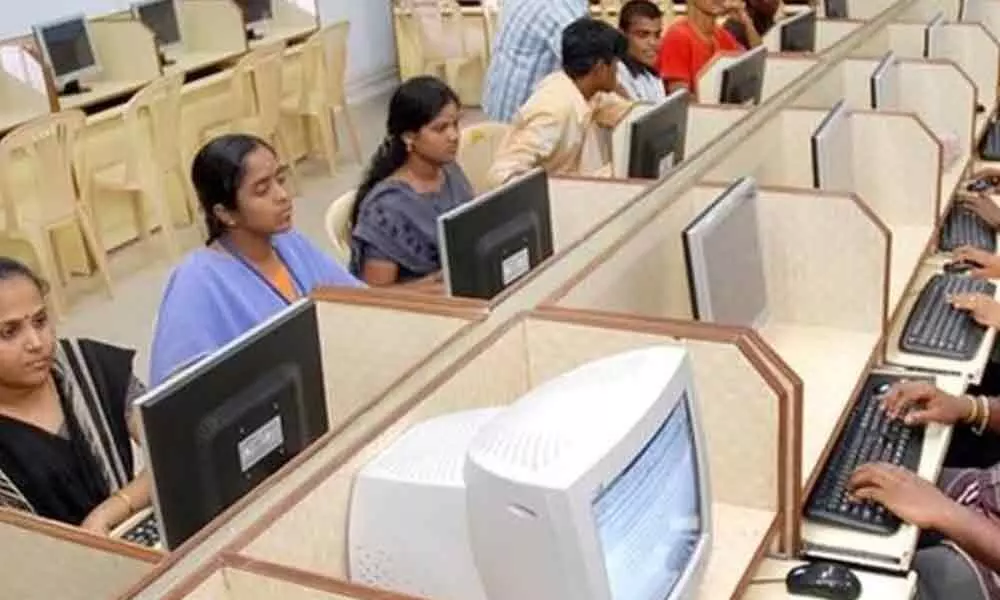Challenges to higher education post lockdown

The UGC suggests that up to seventy-five per cent of the syllabus be taught in physical classrooms and twenty-five per cent be taught using online modes of instruction. This raises the question of how State-level conventional universities and colleges can achieve this. The real problems truly arise at this juncture. The existing classrooms do not meet the requirements of Covid-19 protocols. The possible ways in which classrooms can be revamped is yet to be figured out. In some cases, it has to be seen whether any amount of revamping is at all feasible. Even if the intake for each course is reduced by half, it may still not be possible to effectively implement Covid-19 protocols.
The world is gripped by Covid-19 pandemic, which has been wreaking unprecedented havoc across the globe. It appears that no institution is spared of the adverse effects of this pandemic. The remarks of historians, classifying the present times as an "era of Covid-19 pandemic," no longer look like an exaggeration. Public health experts from across the globe seem to opine that we are not likely to be free of this pandemic in the near future.
In the same vein, the most optimistic of projections estimate that it would take a minimum of two years or more for the world or most parts of the world to return to normalcy. The evidence gathered from previous pandemics suggests that a second wave of infections is very likely. It is going to be more devastating than the first wave we are presently experiencing. In view of the present circumstances and the expected future trajectory of the Covid-19 pandemic, one of the biggest challenges facing us is about how societies and institutions can adapt and sustain themselves, until the elimination of the virus. The response to this challenge will depend on the decisions and measures taken by national and regional governments, policymakers, regulators and civil society groups. The suitability of the response will be informed by the efficacy of such decisions and measures and how efficiently they can be implemented.
In India, in the context of higher education, the University Grants Commissions (UGC), the chief regulator of higher education in the country, has recently come out with a report – in the nature of a roadmap for institutions of higher education. This report only suggests guidelines. It does not offer tangible solutions to challenges that various institutions of higher education, at different levels, are likely to face once the lockdown (in its present form) is lifted. The State governments and institutions of higher education must leverage these guidelines, to formulate action plans for efficiently adapting the administration and instruction of higher education to new normal.
Immediate concerns: These can be divided into three primary concerns – (a) End term examinations and results; (b) Entrance exams; and (c) Admissions process. In relation to these aspects, the UGC has provided several schedules in its report. The UGC has suggested that all of the schedules must be implemented by incorporating Covid-19 protocols such as social and physical distancing and ensuring required levels of hygiene. According to the report of the UGC, final semester examinations must be conducted between July 1 – July 15; and Intermediate semester examinations must be conducted between July 16 – July 31. Results of final semester examinations and of intermediate semester examinations must be declared by July 31 and August 14, respectively. The easiest type of examination, among the types suggested by the UGC, is the multiple-choice question based examination. This type of exam can be conducted online or offline using OMR sheets.
It would be easy to conduct this type of exams, evaluate and declare results within the timelines prescribed by the UGC. However, the nature and kinds of multiple-choice questions are to be determined, taking into account the specificities of different courses. Essential infrastructure for teaching and learning methods: The UGC suggests that up to seventy-five per cent of the syllabus be taught in physical classrooms and twenty-five per cent be taught using online modes of instruction. This raises the question of how State-level conventional universities and colleges can achieve this. The real problems truly arise at this juncture. The existing classrooms do not meet the requirements of Covid-19 protocols. The possible ways in which classrooms can be revamped is yet to be figured out.
In some cases, it has to be seen whether any amount of revamping is at all feasible. Even if the intake for each course is reduced by half, it may still not be possible to effectively implement Covid-19 protocols. There is a growing concern being articulated by the student community that most students at conventional universities and colleges belong to poor and weaker sections of society. The family homes of these students and their neighbourhoods/localities are presently not suited to facilitate learning online modes. It must be borne in mind that it is not possible for most of these students to equip themselves with smartphones, laptops or computers and workable broadband connections during these difficult times.
On the other hand, it is far from clear if universities and colleges themselves possess the necessary infrastructure to adapt to online modes of instruction. Further, the ability and willingness of faculty members and instructors who have long been accustomed to classroom teaching methods, to adapt to online modes of instruction presents a grey area.
With regard to use of classrooms, college buildings and precincts, the availability of resources to maintain a high degree of sanitation throughout the academic year is an issue that ought to be prioritised.
This would require funds and human resources. Another critical issue is that use of libraries, which play an important role at universities and colleges. A significant number of students rely on the use of libraries to prepare for competitive exams – a popular means of attempting to secure stable employment. The present state of libraries at most universities and colleges does not induce optimism about being able to adapt them to Covid-19 protocols. For example, in the case of the central library of Osmania University, crowds of students often compete to find a seat in the library. It is not going to be easy to overcome these issues. As a temporary measure, reading rooms must be conceptualised and organised. However, this may only be possible at colleges with adequate usable space.
Managing hostels and mess: Issues pertaining to implementation of Covid-19 protocols at hostels and mess will afflict universities and some public and private colleges. Several universities find themselves teeming with students in their hostels. To add to this, the menace of unauthorised stay by non-boarders has been prevalent at public universities for decades. This issue can be best termed as controversial, and managements have since long maintained their unwavering silence about it. There are no easy solutions to this kind of complex issues.
They are fraught with structural dimensions – societal, financial, political and administrative. Therefore, there is an imminent need for governments and managements of universities and institutions of higher education to forthwith address and mitigate the issues highlighted in this article with a clear sense of urgency. Any kind of failure in this regard shall adversely affect the state of higher education at conventional universities and institutions of higher education which cater to a majority of students. Governments and managements must be expedient in mobilising funds and human resources and must take steps to ensure the required physical infrastructure for institutions and students alike. After all, the importance of safety of students and quality of education imparted to them must rank high on the list at the turn of this academic year, of all years. (The writer is Head, Department of Political Sciences, Osmania University, Hyderabad. The views expressed are personal)














